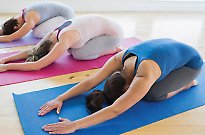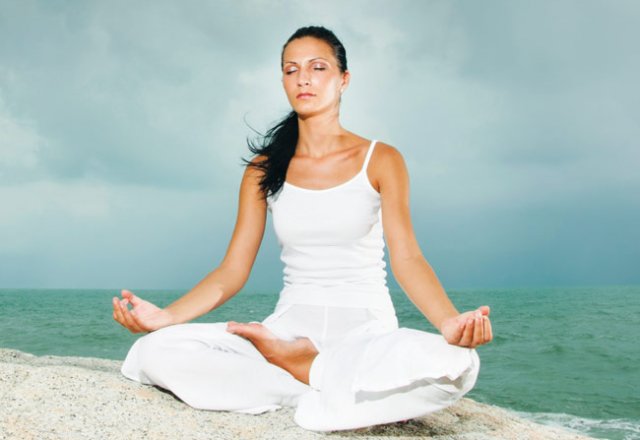
Yoga for high blood pressure

A therapeutic approach
The concept of yoga as an intervention to the management of hypertension or high blood pressure (HBP) is commonly unknown or misunderstood, and yet current research suggests a consistent yoga practice is one of the most effective lifestyle changes one can make to aid in the reduction of medically diagnosed HBP, writes Emma Palmer.
According to a Heart Foundation survey completed in 2010, one in three Australians aged 30 to 65 years have been medically diagnosed with hypertension, equating to 3.5 million Australians. This may be why yoga is now so commonly chosen as a positive, cost-effective lifestyle change to support the management of this somewhat complex process. Although yoga practice is not a panacea, increased research suggests that students who establish a consistent practice identify significant changes in their cardiovascular health. Current clinical treatment of hypertension includes pharmacotherapy, consequently carrying a number of adverse side effects, whereas yoga carries none!
The first key concept is to identify and treat the cause, working with individuals, rather than a generic approach with individual prescriptions; a challenging task when over 95 per cent of cases are idiopathic, meaning patients experience hypertension with an unknown cause. The remaining five per cent of cases identify a possible cause; however, these are vast and can include increased blood sodium levels, ageing, poor lifestyle factors, alcohol, smoking, genetics, increased absorption of high-density lipoproteins (thereby increasing blood cholesterol), genetics, excessive weight gain, sleep apnea and certain prescriptive medications.
Stress and blood pressure (BP)
Functional physiology dramatically changes the stress response by increasing the release of adrenaline and cortisol – designed to manage the fight/flight response of the sympathetic nervous system. These hormones increase heart rate while constricting blood vessels, causing blood pressure to rise. Once the perceived stress has dissipated, the body returns to its original state; however, long term, chronic stress causes blood pressure to increase, causing physiological implications such as heart disease, kidney disease, hardening of the arteries, eye damage and stroke. Yoga practices that increase a relaxed response combat this automatic response, thereby treating the psychophysiological reaction to stress as the cause. Once this is supported, the intention is to then allow the cardiovascular system to rebalance.
Yoga as therapy
In our modern culture, yoga is often considered to be a form of physical exercise, the array of practices that exist under the yogic umbrella include breathing practices, meditation, relaxation, diet, nutrition and other lifestyle factors. Restorative asana (postures) are most beneficial when working with HBP; however, it is crucial to work with a long-term plan and build endurance for the whole cardio-respiratory and co-supporting systems.
Asana, pranayama (breathing practices) and relaxation techniques are the most commonly researched area of yoga for the treatment of BP. According to the European Journal of Cardiovascular Prevention and Rehabilitation article published in 2004, BP reduction was evident in patients who participated in a regular yoga practice. The study found that yoga restored baroreceptor sensitivity, consequently reducing BP measurements. Baroreceptor sensitivity are pressure sensors of the cardiovascular system, found in the arterial walls of the systemic arteries and mid brain. These sensors are active when the arteries are over or under pressured, a process constantly controlled by the nervous system. Further studies attested that restorative postures are considered favourable as they are more likely to strengthen baroreceptors.
Therapeutic asana for HBP
Restorative asana, such as seated forwards bends, support the nervous and endocrine systems, thereby increasing the parasympathetic nervous system, also known as the rest/relax/digest pathways. Forward bends rebalance the renin-angiotensin system, which regulates blood pressure and fluid balance detected when the blood volume is low, resulting in the kidneys secreting hormones to stimulate vasoconstriction, triggering the BP to decrease while increasing the reabsorption of sodium and water into the blood – additionally aiding in BP reduction. Furthermore, studies comparing regular yoga practitioners to healthy people of the same age found that consistent yoga practitioners had enhanced parasympathetic control of the cardiovascular system.
Gentle inversions such as viparita karani (inverted lake posture) directly triggered certain relaxation responses in the body by deactivating the sympathetic ‘fight/flight’ response while activating the parasympathetic. Students with HBP completing their practice while lying down should move into a seated position with caution; it is recommended that students first move to their right side for at least 10 breaths before returning to an upright position.
Relaxation techniques
Research indicates that the benefits of incorporating relaxation techniques include slowing the heart rate, reducing HBP, decreased respiration, decreased muscular tension, increasing blood flow to the muscles, enhanced sleep, boosted immunity, decreased anxiety and pain management to name only a few.
Yoga nidra, known as ‘yogic sleep’, is a powerful relaxation technique prompting one of the deepest possible states of relaxation while still maintaining full consciousness, lasting between 20 to 40 minutes, and can be practised as a stand-alone exercise or at the end of a restorative yoga practice. It is said that 20 minutes of yoga nidra equates to the same physiological response as two hours of sleep!
Pranayama – breathe your way to stillness
Relaxing pranayama practices aim to lower BP and are therapeutic in decreasing HBP by relaxing the nervous and endocrine systems. Research conducted in 2011 identified beneficial effects of 15 days’ pranayama practice on cardiovascular functions irrespective of age, gender, and body mass index (BMI) in healthy individuals. They found a significant decrease in systolic pressure, which means the pressure in the arteries when the heart beats was lowered.
Meditation as medicine
Meditation stimulates certain changes in the nervous system and supports the way in which the cardiovascular system responds to stress and subsequently how it lowers BP. Furthermore, fluctuating levels of stress cause the master gland of the endocrine system, the hypothalamus, to become far less adept at responding to minor imbalances, either increasing or decreasing hormone production. Meditation directly rejuvenates the hypothalamus and acts as an effective counter measure against stress, specifically beneficial for ailments, including cardiovascular disease and stroke, among many others. Some techniques include guided visualisation, breathing techniques, progressive healing relaxation, walking and open-eyed meditation, to name a few.
Yoga practices to avoid
It is strongly recommended that students with HBP (medicated or otherwise) seek advice from their health care practitioner prior to practising any yoga technique to ensure their condition is managed to the extent that they are able to practise.
Strong inversions are contraindicated for HBP due to the pressure placed on the heart while inverted as they elevate BP, generating pressure that may damage blood vessels in the brain. In severe cases, HBP combined with inversions may cause blood vessels to hemorrhage. Interestingly, some studies have shown that the diastolic pressure (the measure of pressure in the arteries between heartbeats) of students practising stronger inversions has been lower than sitting! These results, however, have only been identified in healthy, consistent practitioners of yoga with no presentation of HBP, and a significant amount of research suggests that inversions would be contraindicated, therefore inversions should be avoided.
Strong spine twists are contraindicated as they can increase intra-abdominal pressure also known as intra-abdominal hypertension. As a result, gentle/restorative twists are more therapeutic. Balancing and standing asana are therapeutic for strengthening the cardiorespiratory systems as they use the larger muscle groups of the body; however, BP can increase when the arms are elevated overhead, therefore the arms should be level with the heart to avoid this natural increase.
Breathing practices that increase intra-abdominal hypertension, such as kapalabhati and bhastrika, are also contraindicated, with more restorative, relaxing techniques to be practised instead.
Not only do the yoga practices highlighted support the cardiovascular system, they also support systemic health and organs negatively affected by high blood pressure. Yoga clearly aims to work not only on managing the cause, it aims to manage the presenting symptoms, which conversely can empower any individual to take back control of their health, working with yoga as a therapy for not only health and longevity but also happiness a birth-right for each of us!
Emma Palmer is the principal teacher and director of the Moksha Academy of Yoga mokshayoga.com.au.


